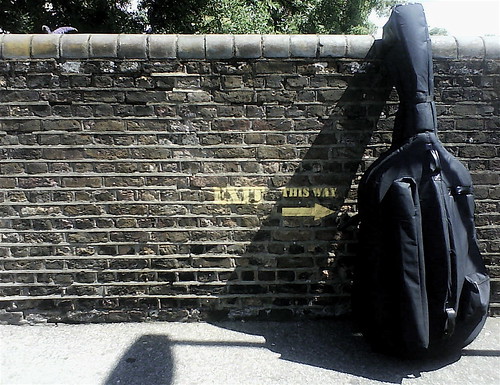 off to the queen elizabeth hall to see john adams leading the london sinfonietta in a programme of works by american composers (including, not unsurprisingly, john adams). things kicked off promisingly with john cage's credo in US - a piece i'd not heard before and dating from 1942. scored for piano, two percussionists and 'radio or phonograph' (here, adams had prepared his own samples of american radio broadcasts). it was a lot of fun, sounding at times like charles ives on hallucinogens. i'm not sure if i was hearing things, but at one point the piano part seemed to be cruelly deconstructing ragtime cliches, removing all the usual dynamics and most crucially any sense of swing. it sounded a bit like jools holland. cage was not a jazz fan, and it showed.
off to the queen elizabeth hall to see john adams leading the london sinfonietta in a programme of works by american composers (including, not unsurprisingly, john adams). things kicked off promisingly with john cage's credo in US - a piece i'd not heard before and dating from 1942. scored for piano, two percussionists and 'radio or phonograph' (here, adams had prepared his own samples of american radio broadcasts). it was a lot of fun, sounding at times like charles ives on hallucinogens. i'm not sure if i was hearing things, but at one point the piano part seemed to be cruelly deconstructing ragtime cliches, removing all the usual dynamics and most crucially any sense of swing. it sounded a bit like jools holland. cage was not a jazz fan, and it showed.next up was paul dresher's two part concerto for violin and electroacoustic band. the electroacoustic bit was actually two keyboardists playing yamaha sample workstations. it's a bit of a meaningless term these days i suppose, but i still think that was pushing it. i've heard a fair bit of dresher's stuff which seems to trawl a fairly barren but not unpleasant stretch of water somewhere between dodgy art rock and proper, serious classical music. this was no different, and as the 'band' took the stage i could see an electric guitarist among them. ooh, radical. there were some nice bits, particularly in clio gould's solo violin parts in the second movement, but the vaguely cosmic prog rock electric guitar just sounded silly (dresher is a guitarist himself and has recorded a lot of competent but boring sub-fripp loop noodling in the past). the electroacoustic bits were confined to prepared piano hits or horrible synthetic strings, which seemed entirely surplus to requirements to my ears. disappointing.
on to david lang, who runs the ubiquitous bang on a can allstars. his cheating, lying, stealing was a short chamber piece for bass clarinet, bassoon, lots of percussion, keyboards and woodwind; there were a lot of 'classic' minimalist techniques on display (it was probably the only piece in the programme that would really merit the term), but they were stretched and played about with in a maximal way. i liked it.
finally, john adams conducted his own son of chamber symphony. adams has never really grabbed me, though i still love a bit of shaker loops on occasion. there was a lot going on here; some nifty instrumental combinations and some very nice double bass lines too. yay. the start of the second movement was beautiful, but soon relapsed into a procession of strident, restless call and response between strings and brass. all very clever, but somehow it all left me a bit cold. i should say i was probably in the minority though.
this was very much the acceptable face of contemporary classical music (not too much dissonance, lots of rhythm etc) so i don't really know why i was surprised at how indifferent much of it left me feeling, even though i was often left in awe by the technical abilities of the players. it says a lot though it's not that surprising that the cage piece was probably the most entertaining and certainly carried the most sense of danger; much of the rest of the music did seem to sum up one of his maxims; 'we've nothing to say and we're saying it'.

